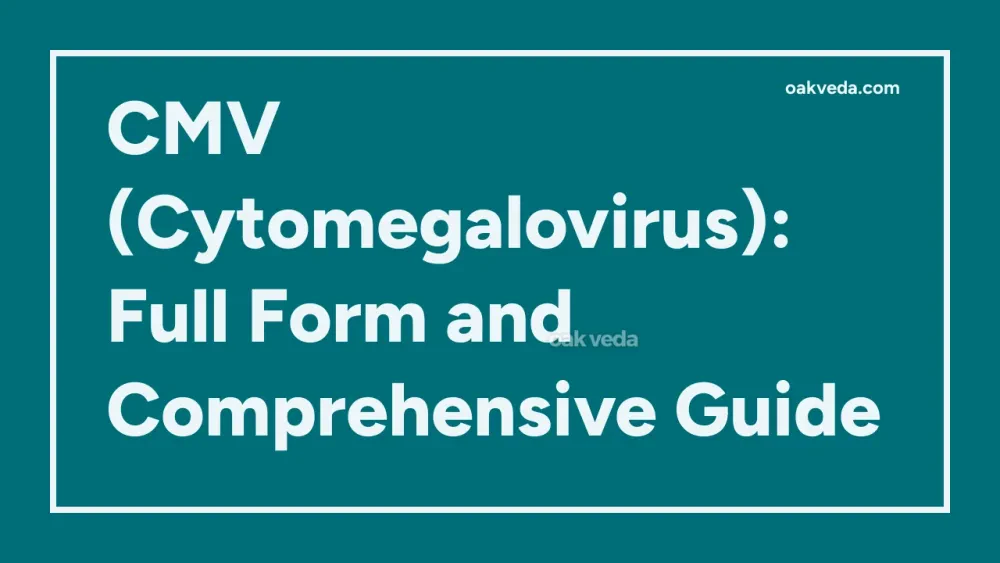
What is the Full Form of CMV?
The full form of CMV is Cytomegalovirus. This common virus belongs to the Herpesviridae family and affects people of all ages. While CMV is generally harmless in healthy individuals, it can pose significant risks to certain populations, particularly newborns and those with weakened immune systems.
What is Cytomegalovirus?
Cytomegalovirus is a widespread viral infection that often goes unnoticed in healthy adults. Once a person contracts CMV, the virus remains dormant in their body for life. Most people with CMV show no symptoms, making it challenging to diagnose without specific blood tests.
Origin and Development of Cytomegalovirus
Cytomegalovirus is an ancient virus that has co-evolved with humans for thousands of years. It was first isolated in the 1950s and has since been extensively studied due to its potential impact on vulnerable populations. CMV is a double-stranded DNA virus, which allows it to replicate efficiently and persist in the host's body.
How does Cytomegalovirus work?
CMV primarily spreads through direct contact with bodily fluids from an infected person. These fluids include:
- Saliva
- Urine
- Blood
- Semen
- Breast milk
- Tears
Once the virus enters the body, it can infect various cell types, including epithelial cells, endothelial cells, and fibroblasts. In most cases, the immune system keeps the virus in check, preventing symptoms from developing. However, in individuals with weakened immune systems, CMV can reactivate and cause serious complications.
Types of Cytomegalovirus Infections
While there is only one type of CMV, infections can be categorized based on their impact and timing:
- Primary infection: Occurs when a person contracts CMV for the first time
- Latent infection: The virus remains dormant in the body after the initial infection
- Reactivation: The dormant virus becomes active again, usually in immunocompromised individuals
- Congenital CMV: Infection that occurs before birth, transmitted from mother to fetus
Functions of Cytomegalovirus in the Human Body
Although CMV is considered a pathogen, it has evolved complex mechanisms to persist in the human body. Some of its functions include:
- Modulating the host's immune response
- Establishing latency in specific cell types
- Reactivating under certain conditions to ensure transmission
Applications of Cytomegalovirus Research
CMV research has led to several important applications:
- Development of antiviral therapies
- Improved understanding of viral immune evasion strategies
- Creation of CMV-based vaccine vectors for other diseases
- Insights into the human immune system and its interactions with persistent viruses
Features of Cytomegalovirus
Key features of CMV include:
- Persistence: Ability to remain in the host's body for life
- Latency: Capacity to become dormant and reactivate later
- Immune modulation: Complex interactions with the host's immune system
- Opportunistic nature: Tendency to cause severe disease in immunocompromised individuals
- Vertical transmission: Ability to pass from mother to fetus during pregnancy
Benefits of Understanding Cytomegalovirus
Studying CMV has led to numerous benefits:
- Improved prenatal screening and interventions
- Development of antiviral treatments for severe cases
- Better management of CMV in organ transplant recipients
- Insights into viral persistence and immune evasion
- Potential for CMV-based vaccine technologies
Limitations or Challenges of Cytomegalovirus Management
Despite advances in CMV research, several challenges remain:
- Asymptomatic spread: Many infected individuals show no symptoms, making containment difficult
- Lack of effective vaccine: No approved vaccine exists for CMV prevention
- Antiviral resistance: Some CMV strains have developed resistance to common antiviral drugs
- Congenital infections: Preventing mother-to-child transmission remains challenging
- Reactivation in immunosuppressed patients: Managing CMV in organ transplant recipients and HIV patients
Future Developments in Cytomegalovirus Technology
Ongoing research in CMV aims to address current limitations:
- Vaccine development: Several candidate vaccines are in clinical trials
- Novel antiviral therapies: Research into new drugs with improved efficacy and reduced side effects
- Improved diagnostic tools: Development of faster, more accurate testing methods
- Gene editing approaches: Exploring CRISPR technology to target CMV DNA
- Immunotherapy: Investigating ways to boost the immune response against CMV
FAQs on CMV Full Form
-
What are the common symptoms of CMV infection? Most people with CMV don't show symptoms. When present, symptoms may include fever, fatigue, sore throat, and swollen glands.
-
How is CMV transmitted? CMV spreads through contact with bodily fluids, including saliva, urine, blood, and breast milk.
-
Can CMV be cured? There is no cure for CMV, but antiviral medications can help manage symptoms in severe cases.
-
Is CMV dangerous during pregnancy? CMV can be dangerous if a pregnant woman contracts it for the first time, as it may lead to congenital CMV in the baby.
-
How can I prevent CMV infection? Practice good hygiene, avoid sharing utensils, and be cautious when handling bodily fluids, especially if you're pregnant or immunocompromised.
Understanding the full form of CMV – Cytomegalovirus – is crucial for public health awareness. While most people carry this virus without issue, its potential impact on vulnerable populations highlights the importance of ongoing research and preventive measures.
You may be interested in:
- UNESCO (United Nations Educational, Scientific and Cultural Organization)
- BDS (Bachelor of Dental Surgery) Full Form
- LOC (Line of Control): Full Form and Significance
- POC (Proof of Concept): Full Form and Explanation
- ISI (Indian Standards Institute): Full Form and Meaning
- DTP (Desktop Publishing): Full Form and Overview

